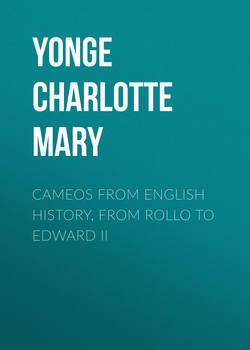Cameos from English History, from Rollo to Edward II

Реклама. ООО «ЛитРес», ИНН: 7719571260.
Оглавление
Yonge Charlotte Mary. Cameos from English History, from Rollo to Edward II
PREFACE
INTRODUCTION
CAMEO I. ROLF GANGER. (900-932.)
CAMEO II. WILLIAM LONGSWORD AND RICHARD THE FEARLESS. (932-996.)
CAMEO III. YOUTH OF THE CONQUEROR. (1036-1066.)
CAMEO IV. EARL GODWIN. (1012-1052.)
CAMEO V. THE TWO HAROLDS. (1060-1066.)
CAMEO VI. THE NORMAN INVASION. (1066.)
CAMEO VII. THE BATTLE OF HASTINGS. (1066.)
CAMEO VIII. THE CAMP OF REFUGE. (1067-1072.)
CAMEO IX. THE LAST SAXON BISHOP. (1008-1095.)
CAMEO X. THE CONQUEROR. (1066-1087.)
CAMEO XI. THE CONQUEROR’S CHILDREN. (1050-1087.)
CAMEO XII. THE CROWN AND THE MITRE
CAMEO XIII. THE FIRST CRUSADE. (1095-1100.)
CAMEO XIV. THE ETHELING FAMILY. (1010-1159.)
CAMEO XV. THE COUNTS OF ANJOU. (888-1142.)
CAMEO XVI. VISITORS OF HENRY I. (1120-1134.)
CAMEO XVII. THE BATTLE OF THE STANDARD. (1135-1138.)
CAMEO XVIII. THE SNOWS OF OXFORD. (1138-1154.)
CAMEO XIX. YOUTH OF BECKET. (1154-1162)
CAMEO XX. THE CONSTITUTIONS OF CLARENDON. (1163-1172.)
CAMEO XXI. DEATH OF BECKET. (1166-1172.)
CAMEO XXII. THE CONQUEST OF IRELAND. (1172)
CAMEO XXIII. THE REBELLIOUS EAGLETS. (1149-1189.)
CAMEO XXIV. THE THIRD CRUSADE. (1189-1193)
CAMEO XXV. ARTHUR OF BRITTANY. (1187-1206.)
CAMEO XXVI. THE INTERDICT. (1207-1214.)
CAMEO XXVII. MAGNA CHARTA. (1214-1217.)
CAMEO XXVIII. THE FIEF OF ROME. (1217-1254.)
CAMEO XXIX. THE LONGESPÉES IN THE EGYPTIAN CRUSADES. (1219-1254.)
CAMEO XXX. SIMON DE MONTFORT. (1232-1266.)
CAMEO XXXI. THE LAST OF THE CRUSADERS. (1267-1291.)
CAMEO XXXII. The CYMRY. (B.C. 66 A.D. 1269.)
CAMEO XXXIII. THE ENGLISH JUSTINIAN. (1272-1292.)
CAMEO XXXIV. THE HAMMER OF THE SCOTS. (1292-1305.)
CAMEO XXXV. THE EVIL TOLL. (1294-1305.)
CAMEO XXXVI. ROBERT THE BRUCE (1305-1308.)
CAMEO XXXVII. THE VICTIM OF BLACKLOW HILL
CAMEO XXXVIII. BANNOCKBURN. (1307-1313.)
CAMEO XXXIX. THE KNIGHTS OF THE TEMPLE. (1292-1316.)
CAMEO XL. THE BARONS’ WARS. (1310-1327.)
CAMEO XLI. GOOD KING ROBERT’S TESTAMENT. (1314-1329.)
Отрывок из книги
Young people learn the history of England by reading small books which connect some memorable event that they can understand, and remember, with the name of each king—such as Tyrrell’s arrow-shot with William Rufus, or the wreck of the White Ship with Henry I. But when they begin to grow a little beyond these stories, it becomes difficult to find a history that will give details and enlarge their knowledge, without being too lengthy. They can hardly be expected to remember or take an interest in personages or events left, as it were, in the block. It was the sense of this want that prompted the writing of the series that here follows, in which the endeavor has been to take either individual characters, or events bearing on our history, and work them out as fully as materials permitted, so that each, taken by itself, might form an individual Cameo, or gem in full relief, and thus become impressed upon the mind.
The undertaking was first begun sixteen years ago, for a periodical for young people. At that time, the view was to make the Cameos hang, as it were, on the thread furnished by ordinary childish histories, so as to leave out what might be considered as too well-known. However, as the work made progress, this was found to be a mistake; the omissions prevented the finished parts from fitting together, and the characters were incomplete, without being shown in action. Thus, in preparing the Cameos for separate publication, it has been found better to supply what had previously been omitted, as well as to try to correct and alter the other Cameos by the light of increasing information.
.....
It is said that the word “Exchequer” is derived from the court of justice established by Rollo, so called from the word “Schicken” signifying, in his native tongue, to send, because from it judges were sent to try causes throughout the dukedom. It is also said that the appeal from them to the Duke himself, made in these terms, “J’appelle a Rou,” is the origin of the cry “Haro” by which, for centuries after his descendants had passed away from Normandy, the injured always called for justice. This was for many centuries believed in Normandy, but in fact the word Haro is only the same as our own “hurrah,” the beginning of a shout. There is no doubt, however, that the keen, unsophisticated vigor of Rollo, directed by his new religion, did great good in Normandy, and that his justice was sharp, his discipline impartial, so that of him is told the famous old story bestowed upon other just princes, that a gold bracelet was left for three years untouched upon a tree in a forest.
He had been married, as part of the treaty, to Gisèle, daughter of King Charles the Simple, but he was an old grizzly warrior, and neither cared for the other. A wife whom he had long before taken from Vermandois had borne him a son, named William, to whom he left his dukedom in 932.
.....